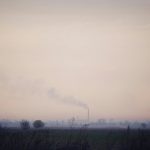PM2.5 and PM10 readings measure airborne particulate matter but differ in size. PM2.5 captures particles 2.5 micrometers or smaller, while PM10 includes those up to 10 micrometers. Smaller PM2.5 particles can penetrate deeper into your lungs, posing greater health risks. In contrast, PM10 particles may cause immediate respiratory issues, especially during physical activities. Understanding the differences is important for evaluating air quality. There’s much more to explore about their sources and health effects.
Table of Contents
Key Takeaways
- PM2.5 consists of particles 2.5 micrometers or smaller, while PM10 includes particles 10 micrometers or smaller.
- PM2.5 poses greater health risks due to its ability to penetrate deeper into the lungs.
- PM2.5 is often associated with vehicle emissions and industrial activities, whereas PM10 can originate from construction and natural events.
- The EPA establishes different air quality standards: 35 µg/m³ for PM2.5 and 150 µg/m³ for PM10 over 24-hour exposure.
- Accurate readings of PM2.5 and PM10 help identify pollution sources and guide public health advisories.
Understanding Particulate Matter: PM2.5 and PM10 Defined
Particulate matter, often referred to as PM, is a mix of tiny particles suspended in the air that can affect your health and the environment.
PM is categorized based on size, primarily PM2.5 and PM10. PM2.5 consists of particles with a diameter of 2.5 micrometers or smaller, while PM10 includes particles that are 10 micrometers or smaller.
PM is classified into two main categories: PM2.5, with particles 2.5 micrometers or smaller, and PM10, up to 10 micrometers.
These size distinctions matter because smaller particles can penetrate deeper into your lungs, posing greater health risks. You might experience issues like respiratory problems or cardiovascular diseases due to exposure.
Understanding these differences helps you recognize the potential impacts of air quality on your well-being. Staying informed enables you to take proactive steps to protect your health against these airborne threats.
Sources of PM2.5 and PM10
While you might think of air pollution as mainly coming from industrial sources, PM2.5 and PM10 originate from a variety of everyday activities and natural processes.
For instance, vehicle emissions release tiny particles into the air, contributing greatly to both PM levels. Residential heating, especially from wood-burning stoves, also adds to the mix.
Outdoor activities like construction and road dust can kick up particulate matter, affecting air quality. Additionally, natural events such as wildfires and volcanic eruptions can produce substantial amounts of PM2.5 and PM10.
Even agricultural practices, like tilling and burning crop residue, play a role.
Understanding these sources helps you recognize how daily life impacts air quality and why monitoring these particles is essential for health.
Size Differences and Their Implications
Understanding the size differences between PM2.5 and PM10 is essential because these particles behave differently in the environment and affect human health in unique ways.
PM2.5 particles, which are 2.5 micrometers or smaller, can penetrate deep into your lungs and even enter your bloodstream. In contrast, PM10 particles are larger, measuring up to 10 micrometers, which means they typically get trapped in your nose and throat.
This distinction matters when considering air quality and pollution sources. PM2.5 can travel longer distances and remain suspended in the air for extended periods, while PM10 tends to settle more quickly.
Recognizing these differences helps you understand the potential risks associated with each type of particulate matter, guiding you to make informed decisions about air quality.
Health Effects of PM2.5 Exposure
When you’re exposed to PM2.5, it can seriously affect your respiratory system, making it harder to breathe.
This fine particulate matter also poses significant risks to your cardiovascular health, increasing the likelihood of heart-related issues.
Vulnerable populations, like children and the elderly, face even greater dangers from this pollution, highlighting the urgent need for awareness and action.
Respiratory System Impact
Exposure to PM2.5 can severely impact your respiratory system, leading to a range of health issues.
These tiny particles can penetrate deep into your lungs, causing inflammation and irritation. You might experience symptoms like coughing, wheezing, and shortness of breath. If you have pre-existing conditions like asthma or chronic obstructive pulmonary disease (COPD), PM2.5 exposure can worsen your symptoms and increase the frequency of attacks.
Even healthy individuals aren’t immune; prolonged exposure may lead to reduced lung function over time. Additionally, you could develop respiratory infections more easily, as PM2.5 can weaken your immune defenses.
Protecting yourself from high PM2.5 levels is essential for maintaining good respiratory health and overall well-being.
Cardiovascular Health Risks
While you may be aware of the respiratory risks associated with PM2.5, its effects on cardiovascular health are equally concerning.
Exposure to these fine particles can lead to serious heart-related issues. Here are some potential risks you should know:
- Increased Blood Pressure: PM2.5 can cause hypertension, straining your heart.
- Heart Attacks: Fine particulate matter increases the likelihood of heart attacks due to inflammation.
- Arrhythmias: Exposure may trigger irregular heartbeats, posing serious health risks.
- Stroke Risk: Long-term exposure raises the chances of strokes, affecting overall brain health.
Being informed about these risks empowers you to take action to minimize your exposure and protect your heart.
Prioritize clean air whenever possible!
Vulnerable Populations Effects
Certain groups of people are more vulnerable to the health effects of PM2.5 exposure, making it essential to understand how these fine particles impact them.
Children, the elderly, and those with pre-existing respiratory or cardiovascular conditions face greater risks. When you breathe in PM2.5, these tiny particles can penetrate deep into your lungs and even enter your bloodstream, exacerbating asthma, triggering heart attacks, and increasing the risk of stroke.
Pregnant women may also experience complications, affecting both their health and that of their unborn child.
If you’re in one of these vulnerable groups, it’s vital to monitor air quality reports and take precautions when PM2.5 levels are high to protect your health and well-being.
Health Effects of PM10 Exposure
When you breathe in PM10 particles, they can greatly impact your respiratory system, leading to issues like asthma and bronchitis.
Over time, exposure to these particles may increase your risk of developing more serious long-term health problems.
It’s essential to understand these risks to better protect your health.
Respiratory System Impact
Exposure to PM10 can considerably impact your respiratory system, as these particles are small enough to penetrate deep into your lungs.
You might experience several immediate effects that can disrupt your daily life, including:
- Coughing and Wheezing: Irritation in your airways can lead to persistent coughs.
- Shortness of Breath: You may find it harder to breathe, especially during physical activities.
- Increased Asthma Attacks: If you have asthma, PM10 exposure can trigger more frequent attacks.
- Reduced Lung Function: Over time, inhaling these particles can impair your lung capacity.
Being aware of these effects is essential for taking proactive measures to protect your respiratory health, especially in polluted environments.
Long-term Health Risks
While short-term effects from PM10 exposure are concerning, the long-term health risks can be even more severe and lasting.
Prolonged exposure to PM10 particles can lead to chronic respiratory diseases, cardiovascular problems, and reduced lung function. You might experience increased asthma attacks, frequent infections, and even lung cancer over time.
Additionally, studies suggest a link between PM10 exposure and neurodegenerative diseases, impacting cognitive health.
It’s essential to recognize that vulnerable populations, such as children and the elderly, face heightened risks.
How PM2.5 and PM10 Are Measured
To accurately assess air quality, scientists employ various methods to measure PM2.5 and PM10 particles.
These measurements help you understand air pollution levels and their potential health impacts.
Measurements of PM2.5 and PM10 reveal crucial insights into air pollution and its effects on health.
Here are four common methods used for measuring these particles:
- Gravimetric Sampling: Air is drawn through a filter, capturing particles, which are then weighed to determine concentration.
- Beta Attenuation Monitoring: This technique measures the decrease in beta radiation as it passes through collected particles on a filter.
- Optical Methods: Laser-based sensors count and size particles based on how they scatter light.
- Chemical Analysis: Lab techniques identify specific chemical compositions of the particles, offering insights into their sources.
Understanding these methods helps you appreciate the complexity of air quality monitoring.
Air Quality Standards for PM2.5 and PM10
Air quality standards for PM2.5 and PM10 play an essential role in protecting public health and the environment. These standards set limits on the concentration of particulate matter in the air, helping you understand when conditions are unsafe.
For PM2.5, the U.S. Environmental Protection Agency (EPA) has established a standard of 35 µg/m³ for 24-hour exposure and 12 µg/m³ for annual exposure. For PM10, the limits are 150 µg/m³ for 24-hour exposure.
Geographic Variation in PM2.5 and PM10 Levels
When you look at PM2.5 and PM10 levels, you’ll notice significant differences between urban and rural areas.
Seasonal changes also play a role, influencing pollution levels throughout the year.
Additionally, geographic sources of pollution contribute to these variations, affecting air quality in distinct ways.
Urban vs. Rural Areas
While both urban and rural areas experience varying levels of PM2.5 and PM10, the sources and concentrations of these pollutants can differ markedly.
In urban settings, you’re likely exposed to higher levels due to:
- Vehicle emissions: Cars and trucks produce significant PM2.5.
- Industrial activities: Factories release both PM2.5 and PM10 into the air.
- Construction sites: Dust from construction contributes to PM10 levels.
- Heating sources: Wood-burning stoves and coal-fired plants increase PM2.5 concentrations.
In contrast, rural areas often have lower pollution levels, mainly due to fewer industrial activities and less traffic.
However, agricultural practices can still introduce PM10 from dust and particulate matter.
Understanding these differences helps you appreciate the air quality variations in your environment.
Seasonal Variations Impact
Seasonal changes greatly influence PM2.5 and PM10 levels, often leading to geographic variations that can affect your health.
In winter, for example, increased heating can raise PM2.5 levels in urban areas, while summer heat can boost PM10 from dust and pollen in rural regions. You might notice that your area experiences spikes in particulate matter during specific seasons, impacting air quality and your well-being.
In addition, weather patterns like rain can temporarily lower these levels, while dry spells can exacerbate them. Understanding these seasonal variations is essential for managing your exposure and protecting your health, especially if you have respiratory issues or allergies.
Keeping track of local air quality reports can help you make informed decisions throughout the year.
Geographic Pollution Sources
Geographic pollution sources greatly impact PM2.5 and PM10 levels, creating noticeable differences in air quality across various regions.
Different areas have unique sources of pollution that contribute to these particulate matter levels. Here are four main sources you should consider:
- Industrial Emissions: Factories release pollutants that considerably increase PM levels.
- Traffic: Urban areas with heavy traffic often experience higher PM2.5 and PM10 concentrations.
- Agricultural Activities: Dust from farming practices can elevate PM levels in rural regions.
- Natural Sources: Wildfires and volcanic eruptions can temporarily spike PM concentrations in affected areas.
Understanding these geographic pollution sources helps you recognize why air quality can vary so much from one location to another.
Mitigation Strategies for Reducing PM2.5 and PM10
To effectively tackle the challenges posed by PM2.5 and PM10, implementing targeted mitigation strategies is essential. You can play a vital role in reducing these pollutants by adopting practical measures at home and in your community.
Here are some effective strategies:
| Strategy | Description |
|---|---|
| Use Air Purifiers | Invest in HEPA filters to trap particles |
| Limit Outdoor Activities | Stay indoors on high pollution days |
| Promote Public Transit | Encourage carpooling and biking |
The Future of Air Quality Monitoring and Regulations
As air quality concerns continue to grow, the future of monitoring and regulations is evolving to meet the challenge.
You can expect significant advancements in how we track and manage air quality, focusing on:
- Real-time data collection: Innovative sensors will provide immediate feedback on air quality levels.
- AI-driven analysis: Artificial intelligence will enhance data interpretation, helping identify pollution sources faster.
- Stricter regulations: Governments will likely implement tougher standards to protect public health.
- Community engagement: Citizens will play a vital role, sharing data and participating in local decision-making.
These changes promise to create a more proactive approach to air quality management, ensuring a healthier environment for everyone.
Stay informed, and get involved in shaping the future of air quality in your community.
Frequently Asked Questions
Can PM2.5 and PM10 Readings Vary by Season?
Yes, PM2.5 and PM10 readings can vary by season. During colder months, you might notice higher levels due to increased heating and stagnant air. In warmer months, dust and pollen can elevate readings considerably.
How Do Weather Conditions Affect PM2.5 and PM10 Levels?
“Every cloud has a silver lining.” Weather conditions notably affect PM2.5 and PM10 levels; temperature inversions can trap pollutants, while rain can clear the air. You’ll notice fluctuations based on humidity and wind patterns, too.
Are There Specific Industries That Contribute More to PM2.5 or PM10?
Yes, certain industries like construction, manufacturing, and transportation greatly contribute to PM2.5 and PM10 levels. You’ll notice vehicles and industrial processes often release more fine particles, impacting air quality in surrounding areas.
What Tools Can Individuals Use to Monitor PM2.5 and PM10 in Their Area?
You can use air quality apps, local environmental websites, or portable air monitors to track PM2.5 and PM10 levels in your area. Staying informed helps you make better decisions for your health and environment.
How Do PM2.5 and PM10 Readings Impact Local Regulations on Emissions?
Think of air quality as a tapestry; each thread matters. PM2.5 and PM10 readings shape local regulations, influencing emission standards. You’ll see tighter rules for higher pollution levels, protecting your community’s health and environment.




